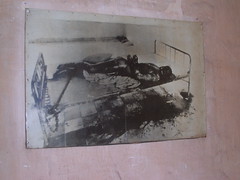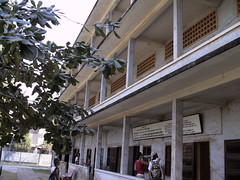Cambodia is an interesting and thought provoking place. Its recent history of genocide bubbles just under the surface of society. We only saw Siem Reap (and the temples of Angkor) and Phnom Penh, and I know there is much more to Cambodia than those major cities. Cambodia wasn’t the best time I had in Asia, but very worthy of further exploration. It would be a great country to come back to and do some volunteer work.
Day 38 – 44, Siem Reap, Cambodia
We flew out of Ko Samui to Siem Reap (via Bangkok airport). Cambodian Visas cost us USD$20 and were processed by very military looking officials. A cabbie (who became our guide for our first day at the temples) picked us up and took us to a couple of hotels within our price range, but we ended up choosing Popular Guesthouse as mentioned in our Lonely Planet book. As the name implies, the place was pretty popular. The facilities were pretty good but I thought at times the service was a little lacking. Nice garden cafe and only USD$8 per night for our comfortable aircon double room, plus an extra dollar for hot water.
Siem Reap is a town that has experienced a boom in the last 5-10 years thanks to the explosion in tourism to the nearby ancient Angkor temples. There are plenty of other things to do besides seeing the temples, but the place has a really artificial vibe, existing purely off tourism and with little character of its own. It is very hard to make any genuine connections with Cambodians here beyond making a transaction, whether it be buying a book or postcards, getting transportation/guide services or whatever. And they are always trying to sell you something. Always. Even if you are just sitting in a restaurant or having a drink in a bar. They’ll ask you “where you from?” then tell you lots of encyclopedia facts about your country then hit you with the hard sell. Unfortunately it’s much easier to just walk away and not engage the locals, even the kids (but a bit of generosity and persistence will get you in good with the kids).
We bought a three-day pass for the Temples of Angkor. This cost us USD $40. The sites we enjoyed were Ta Prohm, with its jungle overgrowth and Bayon with its hundreds of ever-watching stone heads. Angkor Wat itself, of course, is a must see, but there are so many people there, literally thousands walking around at any one time. But it is a stunning achievement in ancient architecture, and is one of the biggest sources of national pride for the Cambodian people (it appears on their national flag).

A shot of a tree growing around a wall. The famous image of Ta Prohm is the large tree strangling one of the main walls with its roots. Lots more great photos of Ta Prohm here.

A small glimpse of the amount of people who visit Angkor Wat every day (Meg is in the centre).

A longer view of Angkor Wat – a hot air balloon for tourists can be seen on the right. Photo courtesy of Meg.

A monk at Angkor Wat. Photo courtesy of Meg.
The Cambodian Landmines Museum is a worthwhile place to visit, albeit a little out of the way. It’s little more than the humble home of Aki Ra, an ex-Khmer soldier who then worked for the UN and for his own NGO in disarming landmines in the area. He has an extensive collection of disarmed landmines, grenades and UXO’s (unexploded ordnances – bombs, mortars, etc). There’s an example of a booby trapped minefield and you can also volunteer to work and live here and help teach english to the many children Aki Ra has taken in that have been injured by landmines. The Landmine Museum is also a pleasant exception from the norm, where you can talk to the locals without them pushing anything on you. There’s a lot of other volunteer work available in Cambodia. If I come back to Cambodia again, I’d like to do a week or so of volunteer work. I think it would be a good way to make a positive contribution and enjoy a holiday of a very different kind.
Speaking of doing positive things and such, we went to the Jayavarman VII Children’s Hospital to see it’s founder, Dr Beat Richner play his cello (“Beatocello“) to raise money and awareness for the treatment of the tuberculosis and dengue fever epidemics that have affected Cambodian children since war tore apart Cambodia. He spoke of the politics and economic policies of the WHO which provide insufficient medical care. If you get over there, they need donations of money and blood…
We ended up spending New Year’s Eve in Siem Reap. Nothing majorly remarkable, the Cambodians don’t celebrate their New Year until April, but Bar Street was alive with a big street party, lots of loud music and alcohol flowing aplenty for the tourists. We ended up in an odd karaoke bar which also seemed to be a disco and a massage parlour of the dubious kind. Meg and I sang drunken songs while we were attended to by our karaoke hostess who didn’t speak a word of english but was quite capable of smiling and nodding.
Another place of interest in Siem Reap was the Artisans d’Angkor Silk Farm, where we saw the complete traditional silk making process (used also as a school for silk making). Pretty nice if you’re interested in that sort of thing, and a nice place to spend half a day, being very well presented and having a swanky gift shop attached.

Butterfly at Butterfly Garden. The Butterfly Garden is a bar and restaurant in Siem Reap that is inside a large mesh cage with hundreds of butterflies going about their business among the flowers and such.
Day 44 – 51, Phnom Penh, Cambodia
We took a bus to Phnom Penh on January 3. After reviewing our budgets we decided to go as cheap as we could, thus we stayed in a backpacker lodge of questionable quality for USD$4 per night. It was cheap and the rooms were so-so but it was right on Boeng Kak Lake, had a good vibe and we met plenty of travellers there that we hung out with and also got good information on Vietnam, our next destination.
I thought Phnom Penh was going to be fun compared to Siem Reap, but it was just different. Truth be told, the most fun I had was hanging out with other travellers at our lodge and at nearby cafes, where we ate, played cards, drank a lot and enjoyed other indulegences that were on offer.
Phnom Penh is a nice enough looking city. Very flat, lots of French-style architecture and pretty much no high rise buildings. Visiting Phnom Penh (and indeed Cambodia) is good if you’re interested in their recent history of genocide, as I was. In a nutshell, in 1976, the civil war in Cambodia, along with the US bombing of the Cambodian countryside precipitated the Khmer Rouge’s rise to power where their leader, Pol Pot envisioned Cambodia abandoning it’s cities, technology and any contact with the West and modernity and returning to a simple agrarian society. He attempted to achieve this by bringing his army of uneducated mountain/farmer folk, moving people out of the cities en-masse and into the farms. Anyone attached to the old regime, as well as the educated classes, wealthy, dissenters, multilingual or even those who wore spectacles were eventually rounded up in prisons, tortured and executed.
Phnom Penh is a very good place to learn about Cambodia’s recent history. Tuol Sleng Prison (codename S-21) was a school that was converted to a prison and place of torture and now stands as a museum to record the atrocities committed there.
The fields of Choeung Ek (known as The Killing Fields) are the mass graves where prisoners were brought and executed, often with hammers, shovels or blunt instruments in order to save on bullets. They were killed as they knelt over pits full of bodies.
Some photos of our time here – don’t forget to click them to enlarge. Some images may be disturbing, though I thoroughly recommend viewing them:

Memorial Shrine at Choeung Ek Killing Fields. A shrine next to the Killing Fields, containing thousands of bones of the mostly unidentified dead.

Unidentified skulls inside the shrine at Choeung Ek.

Mass Graves at Choeung Ek Killing Fields.

Interrogation room at Tuol Sleng Genocide Museum.

Photo of torture victim. When the Vietnamese army came and ousted the Khmer Rouge, they found people tortured, some still alive, in the prison. Black and white photos of some of the victims adorn the walls of the interrogation rooms in the museum today.

A painting by Vann Nath (a survivor of the prison) depicting a method of torture that the US military call “waterboarding” (and is considered by them to be a valid form of “interrogation”)..
As always, there are more photos at my Flickr page.
You can still feel the effects of a country destroyed by its own government, especially in contrast to neighbouring countries Thailand, with its strong economy and vibrant culture, and Vietnam, with its strong national identity and history of winning several wars (against France, USA, Cambodia and China). I think Cambodia is still recovering, economically and culturally, trying to regain its diginity and place in the modern world.
Around this time, I read “First they Killed My Father” which is the story of a young girl (Loung Ung) whose family tried to survive the Khmer Rouge’s genocide. This book and others (which you can buy from vendors for a couple of dollars) can give you a good insight into Cambodia’s recent history.
So, anyway, that was Phnom Penh. While we were there, we organised our Vietnamese Visas which cost us USD $35 (but you can get it a few dollars cheaper if you shop around). Once we had those, we figured boat would be a nice change from buses, so we organised a two day boat trip down the Mekong River into Vietnam.

One comment
1:46 am
Woah what an informative and compelling read! I had limited knowledge about Cambodia and after reading this latest entry I have a better indication of the country, from your perspective and even their own! They have such a tragic history, so I was a little sad to read the facts and see the images. The volunteer work is a great initiative and I know when we were in Ecuador and Peru they had similar programs that you could do.
The fact that you mentioned that people are always trying to sell you something in Cambodia reminded me strongly of Peru, as it’s much the same due to the poverty level (I believe). Going to Ecuador, I expected to get much of the same thing but unlike Peru we never had anyone approach us to sell anything and we noticed the economic differences almost immediately.
Thanks for the valuable read once again! I can’t wait to read up more from your adventures! Take care! Love, all your family back home